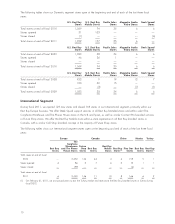Best Buy 2011 Annual Report Download - page 16
Download and view the complete annual report
Please find page 16 of the 2011 Best Buy annual report below. You can navigate through the pages in the report by either clicking on the pages listed below, or by using the keyword search tool below to find specific information within the annual report.The failure to control our costs could have a material adverse impact on our profitability.
Consumer spending remains uncertain, which makes it more challenging for us to maintain or grow our operating income
rate. As a result, we must continue to control our expense structure. Failure to manage our labor and benefit rates,
advertising and marketing expenses, operating lease costs, other store expenses or indirect spending could delay or
prevent us from achieving increased profitability or otherwise have a material adverse impact on our results of operations.
Our liquidity may be materially adversely affected by constraints in the capital markets.
We must have sufficient sources of liquidity to fund our working capital requirements, service our outstanding indebtedness
and finance investment opportunities. Without sufficient liquidity, we could be forced to curtail our operations or we may
not be able to pursue promising business opportunities. The principal sources of our liquidity are funds generated from
operating activities, available cash and cash equivalents, and borrowings under credit facilities and other debt financings.
If our sources of liquidity do not satisfy our requirements, we may have to seek additional financing. The future availability
of financing will depend on a variety of factors, such as economic and market conditions, the availability of credit and our
credit ratings, as well as the possibility that lenders could develop a negative perception of us or the retail industry
generally. If required, we may not be able to obtain additional financing, on favorable terms, or at all.
Changes in our credit ratings may limit our access to capital markets and materially increase our
borrowing costs.
In fiscal 2011, Moody’s Investors Service, Inc. and Standard & Poor’s Ratings Services maintained their ratings and
outlook of our debt securities at above investment grade level, while Fitch Ratings Ltd. reaffirmed its rating of our debt
securities as BBB+ but raised its outlook to stable. Subsequent to the end of fiscal 2011, Fitch Ratings Ltd. reaffirmed its
rating of our debt securities, but revised its outlook to negative.
Future downgrades to our long-term credit ratings and outlook could negatively impact our access to the capital markets
and the perception of us by lenders and other third parties. Our credit ratings are based upon information furnished by us
or obtained by a rating agency from its own sources and are subject to revision, suspension or withdrawal by one or more
rating agencies at any time. Rating agencies may review the ratings assigned to us due to developments that are beyond
our control, including as a result of new standards requiring the agencies to re-assess rating practices and methodologies.
Any downgrade to our debt securities may result in higher interest costs for certain of our credit facilities and other debt
financings, and could result in higher interest costs on future financings. Further, in the event of such a downgrade, we
may not be able to obtain additional financing, if necessary, on favorable terms, or at all.
Our growth is dependent on the success of our strategies.
Our growth is dependent on our ability to identify, develop and execute our strategies. Our failure to properly deploy and
utilize capital and other resources may adversely affect our initiatives designed to assist our customers connect to a digital
lifestyle, while expanding our footprint globally. While we believe our customer centricity and connected world initiatives,
as well as the pursuit of international growth opportunities, will enable us to grow our business, misjudgments or flaws in
our execution could have a material adverse effect on our business, financial condition and results of operations.
Our growth strategy includes expanding our business by opening stores in both existing markets and new
markets.
Our future growth is dependent, in part, on our ability to build, buy or lease new stores. We compete with other retailers
and businesses for suitable locations for our stores. Local land use, local zoning issues, environmental regulations and
other regulations applicable to the types of stores we desire to construct may impact our ability to find suitable locations,
and also influence the cost of building, buying and leasing our stores. We also may have difficulty negotiating real estate
purchase agreements and leases on acceptable terms. Failure to manage effectively these and other similar factors will
affect our ability to build, buy and lease new stores, which may have a material adverse effect on our future profitability.
16
























